| The Coffins Under the Street |

The Coffins Under the Street
Did Portsmouth's "Negro Burying Ground"
fall victim to early commercial expansion?
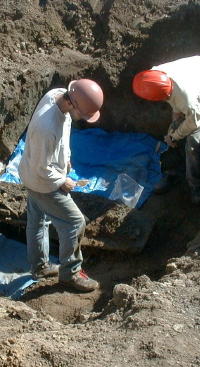 We will be hearing a lot more about the coffins discovered beneath the streets of Portsmouth this week. The rotting 18th century wooden caskets appear to validate a long-held claim that our forebears built the growing city on top of an old "Negro Burying Ground" in the early 1800s. Months before the grave discovery, black historian Valerie Cunningham had been invited to meet with city workers preparing to excavate a sewer line near the proposed burial grounds. Although no human remains were found during previous city pipe work at the corner of Court and Chestnuts Streets downtown, contingency plans were devised. Archeologists hired by the city then tested the region to a depth of two or three feet. When nothing turned up, the digging began. When workers were required to dig deeper a few yards off the planned grid, their backhoe hit something made of wood.
We will be hearing a lot more about the coffins discovered beneath the streets of Portsmouth this week. The rotting 18th century wooden caskets appear to validate a long-held claim that our forebears built the growing city on top of an old "Negro Burying Ground" in the early 1800s. Months before the grave discovery, black historian Valerie Cunningham had been invited to meet with city workers preparing to excavate a sewer line near the proposed burial grounds. Although no human remains were found during previous city pipe work at the corner of Court and Chestnuts Streets downtown, contingency plans were devised. Archeologists hired by the city then tested the region to a depth of two or three feet. When nothing turned up, the digging began. When workers were required to dig deeper a few yards off the planned grid, their backhoe hit something made of wood.
"I think the ancestors are doing something," Valerie told me the following day. But even after decades searching for evidence to support her research, she is cautious and methodical.
"I am not saying that African slaves were discovered on Court Street. Other people may be saying that, but I am not. I want people to trust me, and the only way for them to trust me is for me to be telling them the truth. All we know so far, is that someone was buried there."
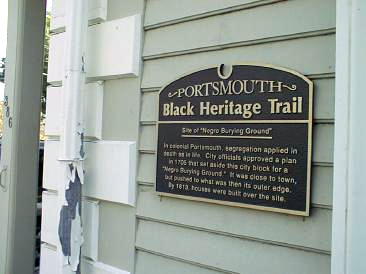
The coffins, five at last count, were found precisely at the address known as Site #10 on the Portsmouth Black Heritage Trail , a walking tour designed by a nonprofit history group. Valerie is president of the group and the trail is built upon 30 years of her extensive research into the city's African-American roots. Without a single surviving grave marker, Site #10 had come to symbolize the indignity of segregation dealt to African-Americans in colonial New England – both in life and in death. Now that story has again risen to the surface like the ancient coffins themselves.
The underlying, although so far unspoken questions are – were early 18th and 19th Century city developers aware of the Negro Burying Ground and did they knowingly build houses, commercial buildings and roads on top of the graves?
"I would assume that in the 1790s that white people developing that area knew," says historian Mark Sammons. "That leaves the question dangling of whether they attempted to move the remains. They might have done their best or they might not have tried at all."
Mark is vice president of the Portsmouth Black Heritage Trail and co-author with Valerie of a forthcoming book on local African American history. He says the official allocation of land for the black cemetery was made in 1705. The site was part of the "glebe" land, a 12-acre parcel now in downtown Portsmouth allocated to the church minister as early as 1640. Following British tradition, a poorly paid minister was allowed to farm or lease a parcel of church land in order to supplement his income. Back in 1705, it is important to remember, the only Portsmouth church was located near the river in the South End, roughly where the fish market stands today near the intersection of Marcy and Pleasant Streets. The glebe land, therefore, including the black cemetery, was originally located far outside the active part of the early city: out of sight, out of mind.
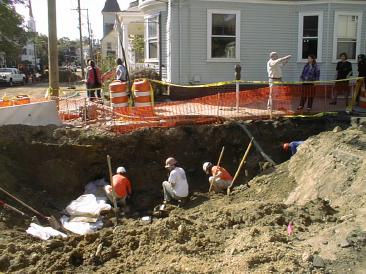
As the city center migrated inland, the glebe land gained commercial value and in 1790 was apparently turned to more productive use. In an elaborate development plan, land leased from the church was divided into new commercial streets. An early map of the development identified the "Negro Burying Ground" where the coffins were discovered last week. That map, however, was lost. Portsmouth historian and newspaper editor Charles Brewster, who reporedly had seen the original, sketched his own copy and it was published in the mid-1800s. Sammons says that in researching the cemetery, he and Valerie originally wondered if the town fathers had mapped around a black burial ground that already existed prior to 1705, or if they had simply assigned the cemetery location and never actually built it.
Sammons' research then turned up a newspaper article that proved the existence of the cemetery. In 1760, while searching for locations to build a farmer's market, the glebe area was proposed. The site was turned down, according to a newspaper account, because it was too far from the center of town and too close to the Negro Burying Grounds. A later map shows the area was built over by 1813. Since then bits of human bone and shards of wooden coffins have reportedly been found during construction in that area, but until this week, no definitive proof appeared.
We now know from Valerie's lifetime of research that enslaved blacks arrived here as early as 1645. African-Americans, freed and enslaved, were active in the local community and even fought in the American Revolution. Did Portsmouth elders, focused on expanding the booming post-Revolutionary economy, attempt to move the remains of the city's freed and enslaved African Americans? Or did they build over their bones in a scenario reminiscent of the horror film "Poltergeist"? If so, how many graves remain under downtown streets and houses and parking lots and back yards?
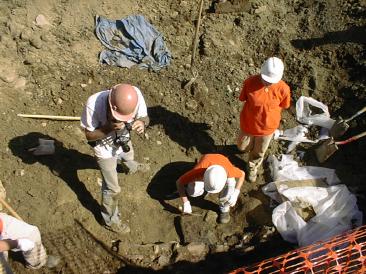
It seems especially ironic, Sammons notes, that if the Court Street burials were built over, it occurred at the same time white Christian cemeteries were being more carefully maintained. Laws were even passed in Portsmouth to prevent locals from grazing their animals on public land that contained graves.
Even with deep research into church and county records, Sammons says, we may never know what happened here. But history can offer clues. First, he says, it is important to remember that this was not a New England cemetery familiar to modern eyes with neat rows of granite or slate tombstones surrounded by a stone wall and an iron gate.
"Try to imagine in your mind's eye," he says. "It was probably a big open field, maybe with footpaths. There may have been a few rough boulders pushed up around the edge. Those who were using the burying grouds may have been very unsure where the burials were and they may have drifted out into where the streets are now."
Yes, it is possible the coffins unearthed contain the bodies of poor citizens who died at the alms house located just up the street. Perhaps the cluster of graves found this week were dug outside the boundaries of the established burying fields. Yes, it is possible that attempts were made to repatriate the remains of the residents of the Court Street burying ground. But if they were moved, why has no record of where they were removed to been discovered? Historians, archeologists and city officials are, as yet, unwilling to speculate. Extensive forensic work, perhaps even DNA testing, will be required, and that work can be costly. At this writing the remains, according to archeologists, are encased in mud that has worked its way into the coffins. Extracting artifacts, if they exist will not be an easy task.
But before that lengthy process begins, here are some facts to consider. According to Valerie's research, Portsmouth's slave population was reported to be 52 in 1727. By 1767 that number had grown to 187, and does not include a population of free blacks and "mulattos". It would not include visiting black sailors, of which there were many in the Age of Sail, or blacks accompanying white Portsmouth visitors, or African-Americans living in neighboring towns.
If the "Negro Buyingl Ground" was established before 1705 and continued in use for as much as a century, is it not possible that a significant number of grave sites still remain buried in the area? Mark Sammons notes that Prince Whipple, enslaved by Portsmouth signer of the Declaration of Independence William Whipple is buried in North Cemetery, largely populate by whites. That may indicate that the Court Street site was out of use by the end of the 1700s, or it may just indicate that Prince and a few other blacks were afforded a special honor due to their record of service. Slaves of the Langdon family were reported buried in obscurity on the family farm off Lafayette Road. But still, he agrees, the total population of the Court Street cemetery, may have been considerable.
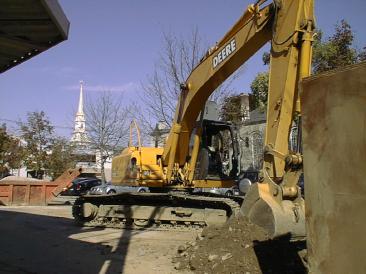
"You're right," Mark Sammons says cautiously, "that's a lot of possible burials over a long period of time. It [the burial ground]could be all the way up the street. Who knows?"
Archeologist Ellen Marlatt who has been working for the city of Portsmouth on the Court Street site with business partner Kathy Wheeler, says finding human remains is not an uncommon around construction projects in the region. Small family cemeteries may turn up, or an unmarked pauper's grave. Although unwilling to speculate on what they have found in Portsmouth, Marlett agrees that this discovery is, perhaps, different. The pair has identified other "sensitive areas" around the "Negro Burial Grounds" that could theoretically contain deep burials.
Sammons says that research generated by this week's find may stimulate much needed discussion about the history of race in this New England city. We are learning more each day about a population that was essentially kidnapped, forced into slavery and poverty, their names and heritage – and possibly their burial grounds – erased.
"White people have gone through a cultural change in the last 30 or 40 years, " he says, "and are more sensitive to the black experience and how brutal it was and that what occurred was wrong."
How wrong, in this case, is pure speculation. So far, we know very little. Soon, we may know much more. Just last week Howard University released the research completed on 400 African-Americans discovered in a burial site in Manhattan in 1991. That huge body of work including DNA studies may shed light on what happened in New Hampshire. Enslaved blacks arrived in New York as early as 1626 and, as here in New Hampshire, share a heritage nearby equal to that of white Europeans. Like here, the African-American burial ground was discovered beneath city buildings.
For the moment, Valerie Cunningham says she is still coming to terms with the Portsmouth discovery. When she first learned about the Court Street coffins in a phone call, she says, she assumed that the caller was referring to the New York burial. Then suddenly she understood that her long search for evidence of her Portsmouth forebears might soon be available at last.
"My heart, I'm sure, skipped several beats," she says. "I felt my flesh crawl."
Over the last 30 years, Valerie Cunningham has come to know the city's African-American forebears by name. She has been telling their stories, working only with bits of paper. Now perhaps, as her Portsmouth Heritage Trail is reaching completion, they have returned. She feels, she admits, a great sense of validation that the mysterious burying ground is a burying ground after all.
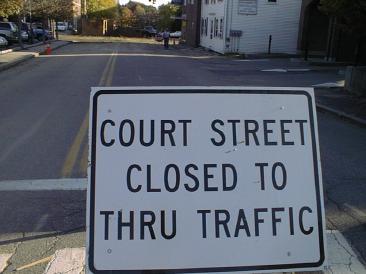
When asked what she hopes the archeologists may find in the months, possibly years of research to come, she thought for a moment. To date, all of her research has been a shuffle of paper. One rare early photograph exists of Prince Whipple's daughter Ester Mollenoux. Otherwise there are no artifacts, no furniture, no portraits, no jewelry, china, silverware or family heirlooms belonging to the hundreds of largely invisible African-Americans who populated this city by the sea. Her research has been largely an act of faith, a long and difficult search into the dimly lit past of a harshly treated people.
"A button," Valerie said finally, in answer to the question. "If they could find just one button, it would mean the world to me."
Visit our BLACK HISTORY section
Copyright © 2003 SeacoastNH.com. All rights reserved..
Article and original photos by J. Dennis Robinson. Top image by Steve Fowle, courtesy of the NH Gazette.
